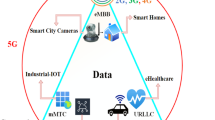Abstract
Cooperative communication has great potential to improve the wireless channel capacity by exploiting the antennas on wireless devices for spatial diversity. The performance in cooperative communication depends on careful resource allocation such as relay selection and power control. In this paper, the network is expanded and more than one source is used. What is proposed is a distributed buyer/seller game theoretic framework over multiuser cooperative communication networks in order to stimulate cooperation and improve the system performance. A two-level Stackelberg game is employed to jointly consider the benefits of the source node and the relay nodes in which the source node is modeled as a buyer and the relay nodes are modeled as sellers, respectively. In this work we proposed coded method in which relays amplify and code Source data and send it to destination at the same time and then signal detection occur in destination, but in the codeless network relays send source data separately to destination. So, here coded and codeless networks are compared and contrasted. The stimulation results revealed that the proposed coded method performed better than the codeless ones; furthermore, the research shows that relays near the sources can play a significant role in increasing source node’s utility, so every source would like to buy more power from these preferred relays. Also, the proposed algorithm enforces truthful power demands.








Similar content being viewed by others
References
Proakis, J. G. (2001). Digital communication (4th ed.). New York: McGraw-Hill.
Su, W., Sadek, A. K., & Liu, K. J. R. (2009). Cooperative communications and networking. Cambridge: Cambridge University Press.
Laneman, J. N., Tse, D. N. C., & Wornell, G. W. (2004). Cooperative diversity in wireless networks: Efficient protocols and outage behavior. IEEE Transactions on Information Theory, 50, 3062–3080.
Laneman, J. (2002). Cooperative diversity in wireless networks: Algorithms and architectures. Ph.D. dissertation, Massachusetts Institute of Technology, Cambridge, MA.
Himsoon, T., Pairat, W. P., Han, Z., & Liu, K. J. R. (2007). Lifetime maximization via cooperative nodes and relay deployment in wireless networks. IEEE Journal of Selected Area in, Communications, 25, 306–317.
Janzamin, M., Pakravan, M. and Sedghi, H. (2010). A game-theoretic approach for power allocation in bidirectional cooperative communication. In IEEE WCNC (pp. 1–6).
Wang, H., Gao, L., Gan, X., Wang, X. and Hossain, E.(2010). Cooperative spectrum sharing in cognitive radio networks: a game-theoretic approach. In IEEE ICC (pp. 1–5).
Fudenberg, D., & Tirole, J. (1993). Game theory. Cambridge: MIT Press.
Osborne, M. J., & Rubinstein, A. (1994). A course in game theory. Cambridge: MIT Press.
Luo, M., Xin, X. and Song,Y. P. (2011). Relay node selection and game theory based power allocation in the cooperative networks. In Proceedings of the IEEE mechanic automation and control engineering (pp. 7555–7558).
Ng, C. Y., Lok, T. M., & Wong, T. F. (2010). Pricing games for distributed cooperative transmission. IEEE Transactions on Vehicular Technology, 59, 3393–3406.
Ghasemi, A., Faez, K. and Dehghan, M. (2006). A new pricing function for power control game in wireless data networks. In Proceedings of the IEEE vehicular technology conference (pp. 1–5).
Chen, L., Libman, L., & Leneutre, J. (2011). Conflicts and incentives in wireless cooperative relaying: A distributed market pricing framework. IEEE Transactions on Parallel and Distributed Systems, 22, 758–772.
Ren, S., & van der Schaar, M. (2011). Pricing and distributed power control in wireless relay networks. IEEE Transactions on Signal Processing, 59, 2913–2926.
Wang, B., Han, Z., & Liu, K. J. R. (2009). Distributed relay selection and power control for multiuser cooperative communication networks using Stackelberg game. IEEE Transactions on Mobile Computing, 8, 975–990.
Author information
Authors and Affiliations
Corresponding author
Rights and permissions
About this article
Cite this article
Mahdavi Lenji, A., Shahzadi, A. Power Allocation in Cooperative Communication System Based on Stackelberg Game. Wireless Pers Commun 84, 123–135 (2015). https://doi.org/10.1007/s11277-015-2597-6
Published:
Issue Date:
DOI: https://doi.org/10.1007/s11277-015-2597-6




